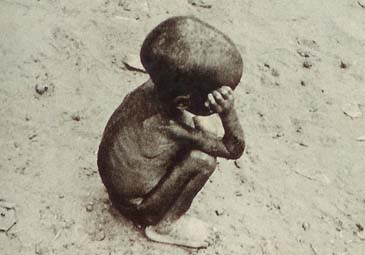 |
| Hunger becomes a global issue |
At first, the numbers don't seem to add up. The world produces more food than ever—enough to feed twice the global population. Yet, more people than ever suffer from hunger; and their numbers are rising. Today, 854 million people, most of them women and girls, are chronically hungry, up from 800 million in 1996. Another paradox: the majority of the world's hungry people live in rural areas, where nearly all food is grown.
World Food Day on October 16 is a good time to try and understand the conundrum of world hunger. The root of the problem is the inequitable distribution of the resources needed to either grow or buy food (also known as poverty). World Food Day is an equally good time to call out one of the main culprits of the crisis: industrial agriculture, the very type enshrined in the Farm Bill that's currently before the US Senate.
The Farm Bill has far-reaching implications for farmers and food systems the world over. It is set to perpetuate a process whereby heavily subsidized US factory farms overproduce grains that are dumped in poor countries, bankrupting local farmers, who can't compete with subsidized prices. We've begun to hear a bit about the plight of these farmers, but few people know that most of them are women. In fact, women produce most of the world's food. They do so on small plots of land, working hard to feed their families and generate enough income for things like school fees and children's shoes.
US Agribusiness: Swallowing Up Lands and Livelihoods
Visit the websites of corporations like Cargill and Archer Daniels Midland, who together control 65 percent of the global grain trade, and you will read that their mission is to "feed a growing world." The reality is starkly different. Big Farming is part of a larger corporate economic model that prioritizes profit-making over all else, even the basic right to food. Around the world, agribusiness bankrupts and displaces small farmers, and directs farmers to grow export crops instead of staple foods.
Not long ago, most farm inputs came from farmers themselves. Seeds were saved from the last harvest and fertilizer was recycled from animal and plant wastes. Farmers found innovative ways to control pests by harnessing local biodiversity, such as cultivating insect-repelling plants alongside food crops. While these techniques can produce enough food to feed the world and sustain its ecosystems, they don't turn a profit for agribusiness. That's why corporations developed genetically modified seeds, chemical fertilizers, and synthetic pesticides.
These inputs are both expensive for farmers and highly damaging to the natural systems on which sustainable farming and, ultimately, all life depends. As the cost of farming has gone up, farmers' incomes have gone down due to trade rules that favor large-scale agribusiness over small farmers. For example, the World Trade Organization's Agreement on Agriculture forbids governments in the Global South from providing farmers with low-cost seeds and other farm inputs, turning farmers into a "market" for international agribusiness.
Over the past 50 years, as much of the world's farmland has been consolidated in fewer and fewer hands, millions of people have been forced to abandon their rural homes. In fact, this year, for the first time ever, the number of people living in cities around the world exceeded the number living in rural areas. Most of this urban population boom is due to rural migration.
Cash Crops and Climate Change
The same practices that have devastated women farmers and their communities worldwide have contributed to environmental destruction that impacts us all.
Export agriculture is a major contributor to global warming because it requires huge inputs of petroleum: it takes 100 gallons of oil to grow just one acre of US corn. It also requires a massive global transportation infrastructure, including ports, railways, fuel pipelines, and superhighways, often built at the expense of local people and ecosystems. In many places, 40 percent of truck traffic is from hauling food over long distances. Today, food that could be grown locally is shipped, trucked, or flown half way around the planet.
Trade rules have so distorted agricultural markets that almost anywhere you go, food from the other side of the world costs less than food grown locally. So people in Kenya buy Dutch butter, while those in the Big Apple buy apples from Chile. In the US, the average bite of food travels 1,300 miles from farm to fork. The system is so wasteful that many countries import the very same foods that they export. For example, last year the US exported—and imported—900,000 tons of beef.
Asserting the Right to Food
The good news is that our global food systems may be on the verge of a great transition. Although agribusiness has unprecedented control over the world's farmers and food supply, the realities of climate change, resource depletion, and the human suffering caused by industrialized farming have led more people to start thinking about the links between food, the environment, and social justice. Around the world, demands for food sovereignty—peoples' right to control their own food systems—is at an all-time high. Even in the US, where much of the population thinks of farming as a quaint and remote activity, more and more people are realizing that if you eat, you're involved in agriculture.
The theme of this year's World Food Day is the right to food. Securing this basic human right for all people, including future generations, will require fundamental changes in the way we use the Earth's natural resources to grow and distribute food. As we face rising temperatures and declining supplies of cheap energy, change will come of necessity. It's up to us—working in partnership with small-scale farmers around the world—to demand a change for the better.
No comments:
Post a Comment